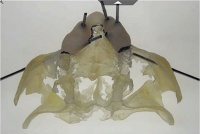Andrew Dawood is director and co-founder of Dawood & Tanner and its research and consultancy arm Cavendish Imaging which performs charitable surgery for the organisations Saving Faces and Facing the World.
‘It’s very niche, there’s very little of it going on,’ Dawood said. ’We feel like we are slowly changing the way some types of surgery are done.’
The practice specialises in dental implants, which in their simplest form are titanium fixtures inserted into the jaw which can be used to replace one or more missing tooth roots. However, some of the patients not only have multiple missing teeth but also damaged jaw bone due to accidents or disease.
For these challenging patients Dawood uses magnetic resonance imaging (MRI) or computed tomography (CT) scans to get a precise 3D schematic which can then be fed directly into rapid prototyping machines to get models and certain temporary prosthetics.
‘We can plan things out on models,’ said Dawood. ’For example, we can make drilling guides and cutting guides to enable us to put the implants in exactly the right place.
‘If it’s a patient who’s missing half their jaw because they’ve had a big cancer, we can actually make guides for bone grafts, so we might take some bone from their shoulder or their hip and transfer it into their jaw we can make guides that shape the bone correctly and fit it into the correct positions.’
The group have the ability to create rapid prototypes using various resins, simple plaster and nylon, which is a good material for surgery, Dawood said, because it is non-irritant and can be sterilized in an autoclave.
At the moment the rapid prototypes are only used to guide surgery or provide a temporary scaffold; the challenge in terms of making rapid prototypes for actual implantable prosthetics is to get cells to grow into the material. But Dawood is optimistic that this will soon be achievable using stem cells or growth factors, which at the moment are prohibitively expensive for routine surgery.
’I see a time when we’re building scaffolds up in resorbable materials…matrices of protein polymers, hydrogels, hydroxyapatite which is a bone-like ceramic, and even bio-glass.’






Nanogenerator consumes CO2 to generate electricity
Whoopee, they've solved how to keep a light on but not a lot else.